skip to main |
skip to sidebar
The Boo Archipelago: Wednesday, 4th February 2015
Torobi Island Zodiac Cruise
The ship anchored off Torobi Island at around 8.30 a.m. This was an additional stop which had been inserted into the programme. Originally, we were to land on the beach but it had been decided that snorkellers would enter the water from a ‘Zodiac Platform’ and that non-snorkellers would be offered a Zodiac Nature Cruise, rather than a landing.
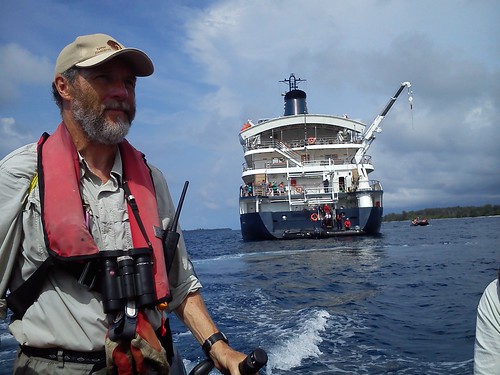 Naturalist and Zodiac Driver Simon Cook in charge of the Nature Cruise. The hydraulic crane at the stern of 'Caledonian Sky' is used to 'launch' and retrieve the Zodiacs.
Naturalist and Zodiac Driver Simon Cook in charge of the Nature Cruise. The hydraulic crane at the stern of 'Caledonian Sky' is used to 'launch' and retrieve the Zodiacs.
We made some interesting bird sightings but what particularly impressed me was the views of the wide variety of coral actually visible from the Zodiac. Firstly, the water was exceptionally clear and secondly there was not too much sea movement. The result was that, even viewing from above the surface, impressions of the magical world of the coral reef below could be obtained.
 The world beneath the surface (1).
The world beneath the surface (1).
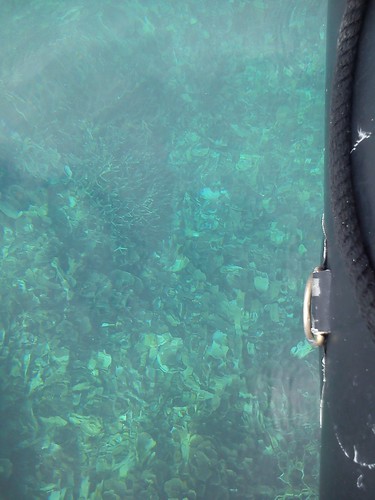
The world beneath the surface (2).
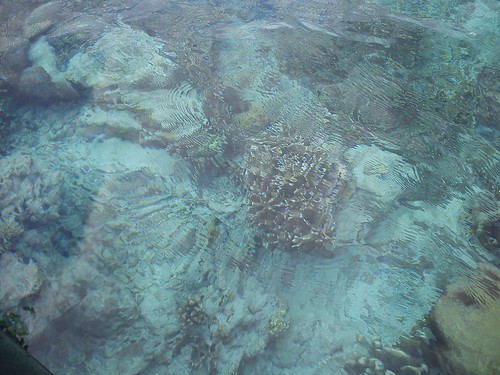 The world beneath the surface (3).
The world beneath the surface (3).
We passed one island where sea cucumbers are being grown commercially but we weren’t able to look at the ‘farm’. Apparently, sea cucumbers are regarded as a delicacy by the Japanese.
 A warning sign near the sea cucumber 'farm'.
A warning sign near the sea cucumber 'farm'.
 Surrounded by islands.
Surrounded by islands.
I would have happily remained out on the Zodiac for hours but we had to return to the ship so that it could re-position to the island of Pulau Boo.
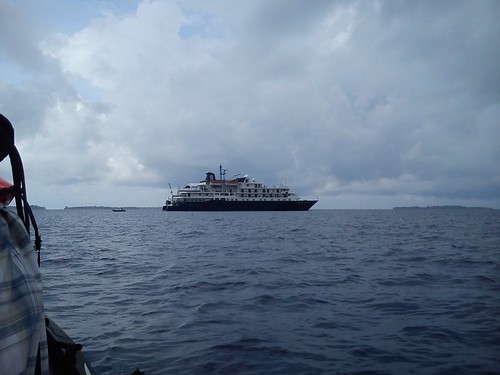 Returning to 'Caledonian Skey' for lunch. There's insufficient room in the 'cradles' at the stern to stow all the Zodiacs so a second hydraulic crane on the starboard side, just astern of the egg-shaped white 'Radome' is used to stow the other Zodiacs on the 'roof'.
Returning to 'Caledonian Skey' for lunch. There's insufficient room in the 'cradles' at the stern to stow all the Zodiacs so a second hydraulic crane on the starboard side, just astern of the egg-shaped white 'Radome' is used to stow the other Zodiacs on the 'roof'.
Whilst this was going on, the passengers took lunch on the ship, most electing for the open air ‘Lido’ restaurant on Deck 5. Unless there’s bad weather, meals could be taken ‘al fresco’ on Deck 5 or in the air conditioned comfort of the main restaurant on Deck 2, without the necessity of making a prior choice.
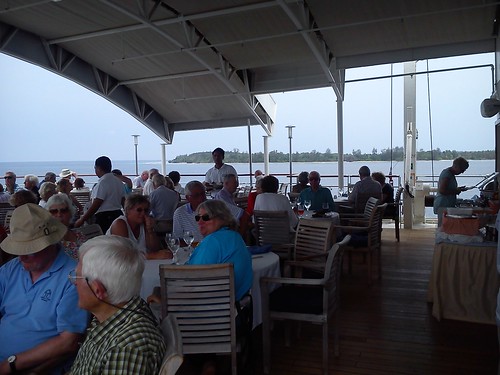 Lunch in the 'Lido' restaurant.
Lunch in the 'Lido' restaurant.
Pulau Boo Landing
Around half past two, the Zodiacs started to ferry people ashore. Separate areas were defined for the Zodiacs, snorkellers and swimmers. Pulau Boo is a small, beautiful ‘Robinson Crusoe’ island, with vegetation (mainly palms) fringed by a narrow, white beach.
 Approaching Pulau Boo in a 'Zodiac'
Approaching Pulau Boo in a 'Zodiac'
On landing, I immediately discovered that the white beach is topped with crushed coral, making footwear desirable. Whilst many of the snorkellers and swimmers were still preparing to enter the water, the sea conditions rapidly became more adverse. I was not surprised that I was making slow progress but the Expedition Team realised that more experienced snorkellers and swimmers were finding the situation uncomfortable. At first the “sphere of operations” was made more restrictive but a little later the order went out “Everybody out of the Water” so that only a small number of determined snorkellers were left in the water and a couple of Zodiacs were brought in close as safety boats.
 The beach at Pulau Boo with 'Caledonian Sky' in the background.
The beach at Pulau Boo with 'Caledonian Sky' in the background.
With swimming curtailed, I decided to walk around the island and I found a number of other passengers doing the same. The sea views were exceptional. In addition to the crushed coral, there were some fairly hefty lumps of various types of coral littered around. In general, the coral was white but I found a piece delicately lined with blue and another white inside but dark brown on the surface.
 A larger piece of 'brown' coral, surrounded by coral fragments.
A larger piece of 'brown' coral, surrounded by coral fragments.
A leisurely walk took about twenty minutes for a complete circuit of the island. I made a brief foray into the palm trees. This was a complete contrast, cool with a green canopy high above. There were a number of fallen trees and large numbers of rotting coconuts lying on the ground.

The interior of the island.
In the changed circumstances, the Expedition Team expedited our return to the ship and by about half past four, the ship was under way.
On to Ternate
Our next ‘Port of Call’, literally, was to be Ternate, in the Molucca Islands, 205 nautical miles from Pulau Boo. I’ll tell you more about our time in Ternate next time.
You can find all the posts on this trip here.
My pictures
The Boo Archipelago.
[Minor revisions, pictures and links added 24-Feb-2015 and 26-Feb-2015.]
Andamatta and Kokas: Tuesday, 3rd February 2015
On Tuesday morning, we were still travelling towards Kokas. After breakfast, I attended a lecture on the life of Captain Cook given by Danny Edmunds of the Expedition Crew.
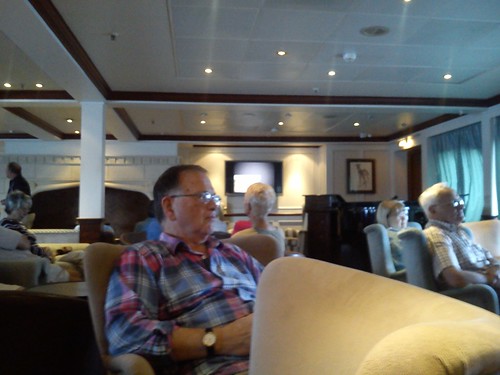 Danny (left background) delivering his talk on Captain Cook. The lounge has four screens for showing presentations, resulting in the audience looking in various directions, which I found a bit odd.
Danny (left background) delivering his talk on Captain Cook. The lounge has four screens for showing presentations, resulting in the audience looking in various directions, which I found a bit odd.
By the time Danny had completed his most interesting history, 'Caledonian Sky' had intentionally travelled beyond Kokas to moor mid-channel at Andamatta (which I think is ten nautical miles beyond Kokas).
By Zodiac to the cliff paintings of Andamatta
We set off from ‘Caledonian Sky’ in the Zodiacs but this time we were accompanied by local guides arranged by Destination Asia (the local agents used by Noble Caledonia).
 Zodiacs being made ready to take passengers to the cliff paintings (port side passengers first, then starboard side).
Zodiacs being made ready to take passengers to the cliff paintings (port side passengers first, then starboard side).
We sailed to the small island which has cliff paintings on the limestone pillar a few feet above the current water level. Known locally as ‘Tapuraran’ these pre-historic rock paintings are made using a red pigment. The primitive images appear to show scenes from the life of the people who made them. Perhaps the most haunting theme was the recurring pictures of a human hand.
 The cliff paintings of Andamatta.
The cliff paintings of Andamatta.
We returned to the ship for an early lunch starting at noon. Whilst we enjoyed another excellent meal, the ship was moved back to a position off the village of Kokas.
By Zodiac to Kokas
As we approached land in the Zodiac, we could see a neat, modern village straggling along the shore. To our left lay a modern jetty built on concrete piles but we headed to the right and landed at an older, smaller stone jetty with uneven steps leading up to road level.
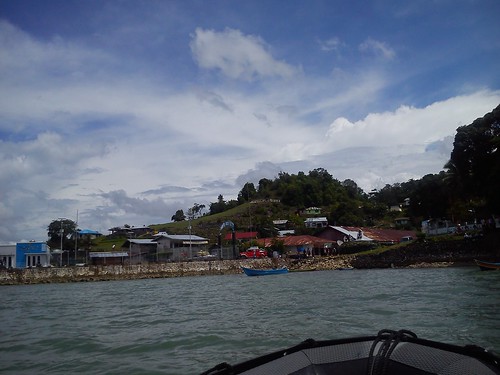 View from my Zodiac nearing the stone jetty with the road approach to the modern jetty on the left.
View from my Zodiac nearing the stone jetty with the road approach to the modern jetty on the left.
 Part of the young welcoming committee on the stone steps.
Part of the young welcoming committee on the stone steps.
Everybody was smiling as a group of local women in some sort of ‘traditional’ dress performed a Welcome Dance in the roadway. It appeared that the whole village had turned out for the event and we were soon surrounded by curious but friendly locals.
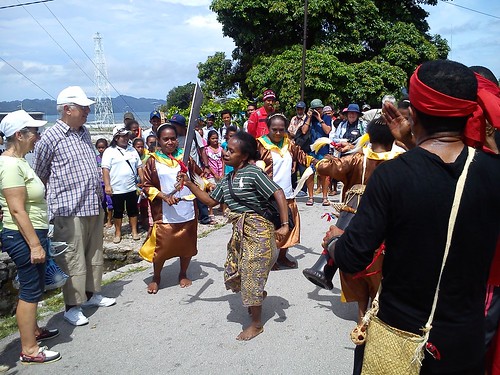 The Welcome Dance.
The Welcome Dance.
There were clearly a number of Muslims from the number of girls and women with their heads covered with colourful scarves. We were invited to walk along the shore road a short distance to a school. A temporary bamboo shelter with seats had been arranged on a grassed area outside the modern buildings where we were invited to sit. We were offered coconut milk (whole coconuts with a square section neatly ‘trepanned’ out allowing a straw to be inserted) and a variety of fresh fruits.
The performance started with a group of the youngest girl students performing an energetic Hula-Hoop dance.
 The Hula Hoop Dance.
The Hula Hoop Dance.
Then a team of women performed the dance where two parallel poles are first separated then ‘clacked’ together by two women whilst dancers try to step in between the poles without getting trapped. Two people from the ship gamely accepted the invitation to try the dance.
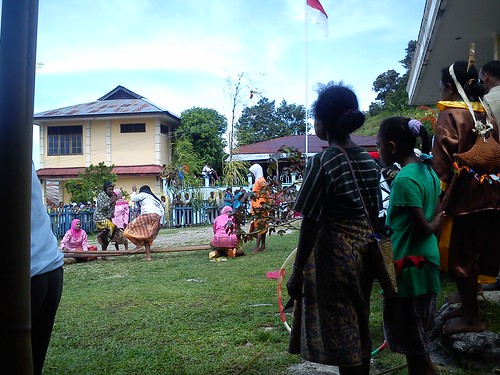 The Pole Dance.
The Pole Dance.
Finally, a group of older girls in another form of ‘traditional’ dress performed a Friendship Dance. When guests were invited to join in, a number of passengers (including me) came onto the ‘floor’. Of course, they then added a couple of ‘changes’ we hadn’t seen before to confuse us but it was a jolly affair.
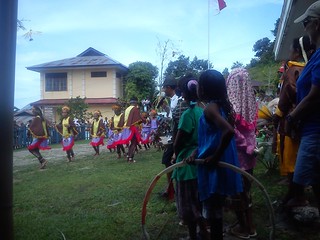
The Friendship Dance.
I’m afraid the proposed visit to the local market was scrubbed, because the market had closed (as normal) at lunchtime. But we were able to walk through the rock tunnels of the Japanese World War II bunker, rather damp and dimly illuminated by a series of pendant electric light fittings. Apparently, the bunker is only opened on special occasions so a number of the young villagers squeezed through with us.
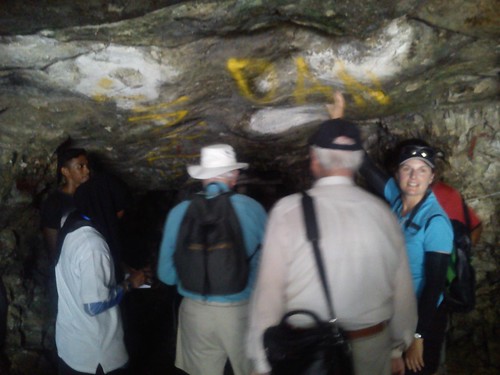 The Japanese Bunker (complete with graffiti).
The Japanese Bunker (complete with graffiti).
There was time to explore a little more of the village before returning to the stone steps and reluctantly saying farewell to the charming population before being returned to our ship by Zodiac.
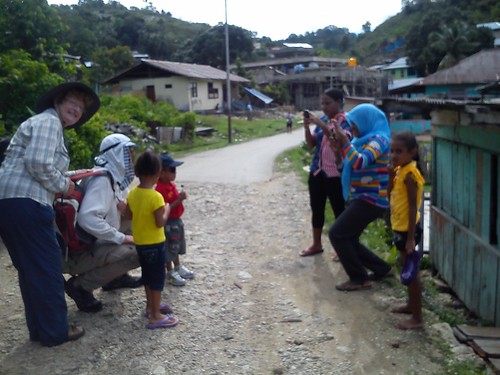 It seemed that most of the villagers had camera/phones and wanted photographs taken with their visitors.
It seemed that most of the villagers had camera/phones and wanted photographs taken with their visitors.
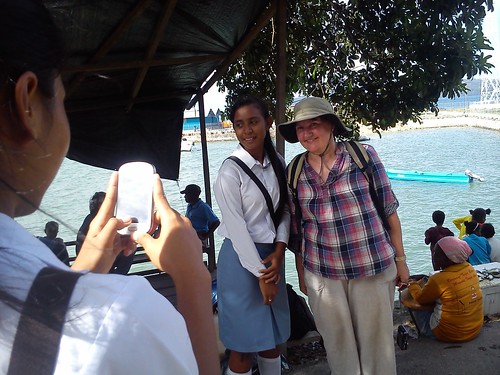 Yet more photographs!
Yet more photographs!
 Our Zodiacs returned us to the ship.
Our Zodiacs returned us to the ship.
On to the Boo Archipelago
At 4.00 p.m., the ‘Caledonian Sky’ started the journey of 201 nautical miles to the Boo Archipelago. I’ll tell you more about that area next time.
You can find all the posts on this trip here.
My pictures
Andamatta.
Kokas.
[Minor revisions, pictures and links added 24-Feb-2015.]
Below is more than you wanted to know about the ship I’m currently travelling on. There are some queries in the issued information which I’ve not yet been able to resolve.
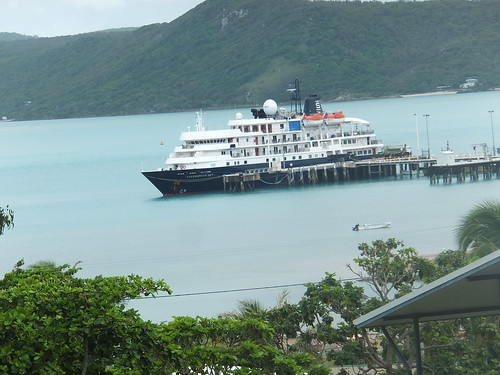 'Caledonian Sky' at Thursday Island, Australia.
'Caledonian Sky' at Thursday Island, Australia.
The Motor Ship ‘Caledonian Sky' is operated by the travel company Noble Caledonia. Founded in 1991, the company specialises in 'small ship cruises'. Their description of 'Caledonian Sky' says:-
"Formerly known as the Hebridean Spirit, the MS Caledonian Sky began her life with Noble Caledonia in May 2012. Accommodating a maximum of 114 passengers in 57 spacious outside suites, she is more akin to a country hotel than the big cruise ships of today. The vessel is the ideal partner to our MS Island Sky, both were built in the same yard and at similar times and share the same excellent attributes that make them two of the finest small ships in the world and we are very proud to have them as our flagships.
Onboard the MS Caledonian Sky there are 57 exceptionally spacious and well designed suites, 23 of which have private balconies located on the Promenade or Bridge Decks. Each suite exudes great character and grandeur with wood panelling and brass features found throughout. The large suites all measure between 20 and 23 square metres and the balconies range in size from 4.2 to 5.6 square metres. Suites are arranged over four decks and all have outside facing views. All suites feature a sitting room area complete with coffee table, armchairs and flat screen televisions (DVD players and DVDs can be borrowed from reception for use in your suite). The beds in each cabin offer exceptionally comfortable mattresses and pillows and can be configured as large double beds or twins."
 A view of cabin 'Isle of Gigha'.
A view of cabin 'Isle of Gigha'.
There's more from Noble Caledonia here.
The ship was built by Nuovi Cantieri Apuania in Italy in 1991 for Renaissance Cruises Inc. Initially named Renaissance VI, she was later Sun Viva 2, Megastar Capricorn, Hebridian Spirit, Sunrise before assuming her current name, Caledonian Sky. The Maritime Connector site will indicate the ship's current position (provided AIS information is being received) and it gives dates for the various name changes:-
SUNRISE until 2011 Sep
HEBRIDEAN SPIRIT until 2009 Apr
CAPRI until 2001 May
MEGASTAR CAPRICORN until 2001 Mar
SUN VIVA 2 until 2000 Apr
RENAISSANCE SIX until 1998 Dec
I believe 'Caledonian Sky' is currently owned by the daughter of the founder of Salén Ship Management AB through a holding company in the Bahamas called Caledonian Sky Shipping Inc,
The ship is operated by Salén Ship Management AB, based in Gothenburg, Sweden and is on long-term lease to Noble Caledonia.
The information below is derived from the information book placed in cabins on board or the Salén Ship Management Website (unconfirmed, with only minor editing):-
NAME: Caledonian Sky
FORMER NAMES: Sunrise, Hebridean Spirit, Megastar Capricorn, Sun Viva II, Renaissance Six
TYPE: Passenger Vessel
NUMBER OF PASSENGERS: 114
NUMBER OF CREW: 71
OWNER: Caledonian Sky Shipping Inc, Bahamas
OPERATOR/MANAGER: Salén Ship Management AB, Sweden
CHARTERER: Noble Caledonia Ltd, London, UK
PORT OF REGISTRY: Nassau, Bahamas
BUILDERS: Nuovi Cantieri Apuania, Italy
BUILT: 1991
RETROFIT: 2001/2009/2011 by George Prior Engineering, Great Yarmouth
CLASSIFICATION: +100 A1 Bureau Veritas
PASSENGER CLASSIFICATION: Passenger Vessel under Bahamas Maritime Administration
LENGTH OVERALL (LOA): 90.6 m
LENGTH BETWEEN PERPENDICULARS (LBP): 78.8 m
BREADTH (MOULDED): 15.3 m
DRAUGHT (MAXIMUM): 4.20 m
DEPTH (UPPER DECK): 5.85 m
SPEED: 14 knots maximum
GROSS TONNAGE: 4,200
NET TONNAGE: 1,263
LIGHTSHIP DISPLACEMENT: 2,606 tons
LOADED DISPLACEMENT: 3,291 tons at 4.2 m draft
FRESH WATER CAPACITY: 220 tons (plus production capacity on board of 45 tons/day)
NAVIGATION EQUIPMENT:
Fully Certified Transas ECDIS (Electronic Chart Display and Information System)
Two JRC Arpa Radar Sets
Two SAAB DGPS
One JRC Echo Sounder
One Gyro Compass with Electronic Interface to Satellite Communications systems and Radars and Exterior Repeaters
One Anschute Autopilot and Conning Wheel
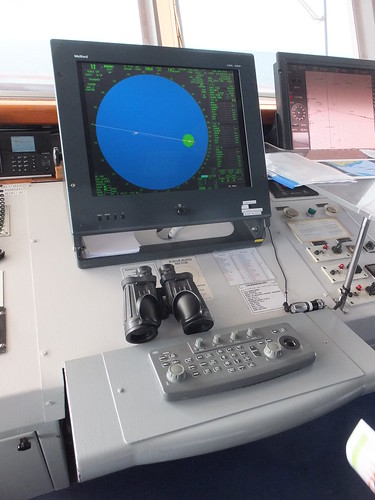
One (of two) Radar Displays, with the main ECDIS display on the right. Note the well-used binoculars - the 'Mark One Eyeball' is still a vital adjunct to the electronics.
 The Anschute Autopilot and Conning Wheel.
The Anschute Autopilot and Conning Wheel.
COMMUNICATION EQUIPMENT:
One V-SAT Satellite
One VHF Unit with Ten Handheld VHF Units
One Navtex Navigational and Weather Report Telex Receiver
One Global Maritime Distress Safety System (fully integrated to a Global Positioning System for instant radio transmission of distress to Coastguard, giving position of a vessel to an accuracy of a few yards and also capable of receiving information from Coastguard)
Two VHF DSC units
Two SAT-C GMDSS units
One MF/HF Radio unit
 The Communications Console on the Bridge of 'Caledonian Sky'. Note the VHF Transceiver (in between the two printers) set to Channel 16, the 'hailing frequency'.
The Communications Console on the Bridge of 'Caledonian Sky'. Note the VHF Transceiver (in between the two printers) set to Channel 16, the 'hailing frequency'.
LIFE SAVING APPARATUS:
Four Motor Lifeboats (each 48 person capacity)

One of four 48-person motor lifeboats, mounted on davits.
Two Inflatable Liferafts (each 25 person capacity)
Loose Equipment (commensurate with the ship’s total complement)
SAFETY SYSTEMS: The vessel is fitted with fire detection/alarm systems, low level lighting and watertight door to a modern high standard in compliance with the latest International Maritime Safety Requirement
SMALL BOATS: Ten ‘Zodiacs”
MAIN ENGINES: Two MAN/B&W Alpha 8-cylinder 8L 28/32A, each developing 2,360 b.h.p. (1,760 kW) at 750 r.p.m. (cylinder bore: 280 m.m., stroke: 320 m.m., engine start by compressed air, Fuel: Marine Gas Oil and Intermediate Fuel Oil, built in Denmark)
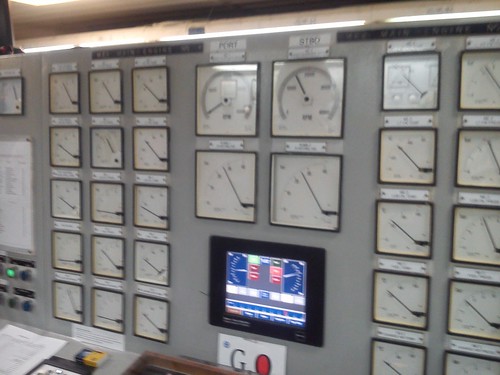 View of the Control Console for the two Main Engines in the cramped Engine Control Room.
View of the Control Console for the two Main Engines in the cramped Engine Control Room.
AUXILIARY ENGINES: Two MAN/B&W Holby 5L 28/32, each developing 1,000 kW at 720 r.p.m. (cylinder bore: 280 m.m., stroke: 320 m.m, generating capacity: 2 x 1,250 kVA, emergency generator: 300 kVA or 240 kW)
SHAFT ALTERNATORS: Two each 800 kW (a Power Take-Off from the Main Engines allows the utilisation of electricity produced to supply the vessel’s electrical demand whilst at sea)
SHIP’S VOLTAGE:
440v 3-phase 60 Hz
220v single-phase 60 Hz
110v single-phase 60 Hz
PROPELLORS: Two B&W Alpha Controllable Pitch Propellors (4 blades at 2.8m dia., Propellor Shaft 15m in length)
STEERING GEAR: Two Frydenbo HS30 2D electro-hydraulic rotary vane units (each comprising an electric motor driven variable-delivery pump delivering pressure to rotary vane unit fitted to each rudder stock)
BOW THRUST UNIT: Brunvoll FU-45LTC-137 Transverse Thrust Unit (capable of transmitting 447 kW and used in conjunction with a Controllable-Pitch Propellor allowing the vessel to be manoeuvred in ports and confined waters)
STABILISERS: Blohm & Voss SK 10-3m 22 (?) Retractable Folding Fins controlled hydraulically (Stabilisation not only adds comfort to clients, but also reduces stresses caused by rolling of vessel in adverse weather conditions)
WINDLASSES: Steen Vertical Cable Lifters (electrically driven)
BOILERS: Aalborg AQ-12 providing 2500 kg/hour at 7 Bar pressure (the steam is used to heat the hot water heat exchangers and auxiliary equipment around the ship)
WATER MAKERS: Two Rochem type RORO 1530-DT-30S Reverse Osmosis Plants producing in total 45 tons/day with UC (?) filtration/chlorine injection (these units produce fresh water from sea water by Reverse Osmosis whereby freshwater permeates a semi-permeable membrane from sea water at a pressure of 60 Bar [around 850 p.s.i.] leaving salts behind)
OILY WATER SEPARATOR: Type RWO m3/hour separation capacity (?) with final discharge quality 15 p.p.m. or less oil content (IMO approved to MARPOL and US Coastguard requirements)
SEWAGE TREATMENT: Two Hamworthy Super Trident Units capable of processing 20 tonnes (?) per day (these units convert the sewage biologically to water of a quality to be discharged overboard).
MMSI: 311061100. [The Maritime Mobile Service Identity number uniquely identifies ships and maritime installations for communications purposes. See the Wikipedia article here.]
IMO: 8802870. [The IMO number (mandated under the Imternational Maritime Organisation's SOLAS convention) uniquely identifies a ship's hull. See the Wikipedia article here.]
You can find all the posts on my trip aboard 'Caledonian Sky' here.
My pictures
Joining 'Caledonian Sky'.
'Caledonian Sky' Bridge.
Engine Control Room, 'Caledonian Sky'.
[Minor revisions 9-Feb-2015, further changes 17-Feb-2015, 24-Feb-2015, 26-Feb-2015]
Leaving Syuru and heading for Triton Bay : Sunday, 1st February 2015
Before our ship departed for Triton Bay, we had an Early Morning Zodiac Cruise. We left the ship and headed towards Syuru village where we’d had such a remarkable visit the previous afternoon.
 View of part of Syuru village from the Creek.
View of part of Syuru village from the Creek.
This time, it was much quieter. Because it was near high tide, the mudbanks which had been such a feature of our arrival the previous day were covered in water. We were able to continue up the creek on our right and on our left past part of the village which was just waking up. We exchanged greetings with some of the villagers before crossing to the right hand side of the creek to study the mangroves. The Asmat Swamp is a wetland sometimes claimed to be the largest alluvial swamp in the world. It is a diverse area. The creek we were on was, of course, tidal so the dominant species were the mangrove and the nipah palm which have adapted to a saline environment. For more information about these interesting adaptations, see the Wikipedia articles Mangrove and Nypa fruticans.
 The distinctive appearance of Mangroves with the 'root system' lifted out of the water.
The distinctive appearance of Mangroves with the 'root system' lifted out of the water.
Inland, the swamp is fresh-water allowing a wider variation of vegetation to develop. After an interesting cruise along the creek, we returned to the ship at 9.00 a.m. The ship’s funnel was already emitting dark smoke, suggesting that the main engines had been recently started prior to getting under way on the next leg of our voyage – the 283 nautical miles to Triton Bay.
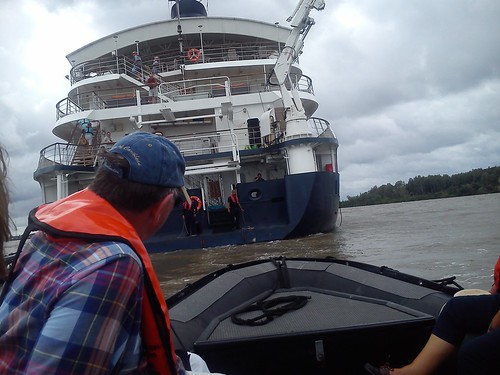 Approaching the special "marina deck" incorporated into the stern of 'Caledonian Sky'.
Approaching the special "marina deck" incorporated into the stern of 'Caledonian Sky'.
During the day, there were three lectures on diverse topics but I was still trying to document our earlier adventures and transfer my photographs onto my notebook computer for safe keeping. Later in the afternoon, there was time to visit the Bridge. During daylight when the ship was underway in 'open water', there was an "Open Bridge" policy, so I was a fairly frequent visitor.
 View of the Arafura Sea from the Bridge, late afternoon on 1st February 2015.
View of the Arafura Sea from the Bridge, late afternoon on 1st February 2015.
Triton Bay : Monday, 2nd February 2015
We were still travelling towards Triton Bay when I took breakfast on Monday.
 Nearing Triton Bay, early morning, 2nd February 2015.
Nearing Triton Bay, early morning, 2nd February 2015.
At 9.00 a.m., I attended the lecture by Lea McQuillan, a naturalist from the ship’s Expedition Team, about the Coral Triangle. By the time this interesting lecture was complete, the Captain had moored at Triton Bay in deep water and the Zodiacs were being made ready to offer a Zodiac cruise of Triton Bay.
Zodiac Cruise
We set off by Zodiac for a network of small islands in Triton Bay, limestone pillars fringed with trees struggling to remain attached. Tidal action had eroded the limestone at water level so as to undercut the pillar, leaving the columns balanced on a much smaller base.
 Passing between two limestone islands, showing the remarkable 'undercutting' at water level.
Passing between two limestone islands, showing the remarkable 'undercutting' at water level.
The Zodiac enabled us to examine the trees and flowers on the islands close-up. At one point, there was a cave large enough to actually take the Zodiac inside. The area only seemed suitable for craft like the Zodiacs but suddenly a large passenger vessel appeared, the K.M. ‘Wally Philan’ and sailed right past us. There were at least a couple of hundred local people on the foredeck, the roof of the superstructure and the afterdeck, all apparently delighted to see us, waving and cheering. Our 'local expert', Oswald, from Destination Asia, confirmed that it was a regular ferry service. The 'K.M.', he said, stood for 'Motor Ship' and the name would be the owner's name.
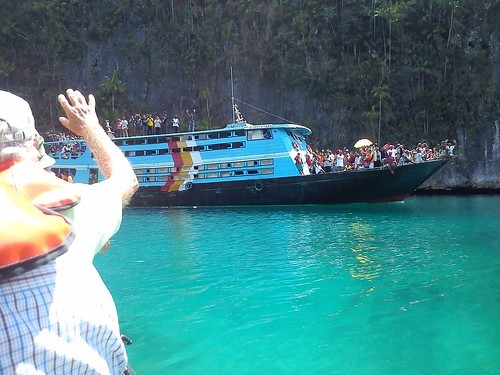 Lots of enthusiasm, not so much Health and Safety.
Lots of enthusiasm, not so much Health and Safety.
Ashore in Triton Bay
After lunch, the Zodiacs took us to a sandy beach where we disembarked into water a few inches deep (a ‘wet landing’) The weather was good and there was a narrow beach of fine, white sand leading to the water’s edge, allowing both swimming and snorkelling. But a number of people reported that the pull of the tide was greater than expected and, after a bit of floating around, I found that I was getting buffeted by the tide so I retired to the sand. Later, I walked the extent of the beach with some of the ‘beachcombers’ from the passengers.
On to Andamatta and Kokas
Once again, the ‘Caledonian Sky’ sailed overnight to our next destination – this time Kokas and Andamatta. I’ll tell you more about that area next time.
You can find all the posts on this trip here.
My pictures
Triton Bay.
[Minor revisions, pictures and links to pictures added 24-Feb-2015]
Syuru and Agats: Saturday, 31st January 2015
As our Zodiac approached the shore, we could see a large number of dugout canoes, each made from a single tree-trunk which I estimate was 15 to 20 feet long and quite narrow. Each was being paddled towards our group of Zodiacs by a number of standing men using simple wooden oars. There were also crowds of men gathered on the shore. They were all chanting in time with a drumbeat from the shore, each rower thrusting his oar vertically down into the water before levering the craft forward.
The first boat to reach us was much larger than the other boats but still long and thin. I think it was of wooden plank construction – it was certainly propelled by an outboard motor at the stern. There were three men in modern dress plus one in a tribal costume, clearly a Chief. The Chief was a commanding figure, dressed in a long grass skirt, bare chested but wearing a traditional headpiece with two white, fringed extensions, like horns. As he chanted, he periodically punched the air with one arm. His exposed coffee-coloured skin had been covered with traditional markings in white on his face, arms and torso.
The dugout canoes surrounded our Zodiacs and stopped paddling but kept up the rhythmic chanting. Each canoe had two or three rowers and all were in a version of tribal costume, ranging from simply body painting with a pair of modern mid-length sports shorts to variations on the Chief’s attire with long grass skirts, head pieces and body painting. The body painting was in apparently individual styles including completely white-face, a white ‘U’ on the lower face (like a beard) or a ring around the eyes. Some of the men also had red body paint in addition to white. In the bewildering variety of this melee of boats, with the incessant chanting, it was difficult to make observations. If the ceremony had originally been intended to terrify visitors, it was certainly successful – this was the most fierce-looking welcome I have ever had. Some of the canoes also had passengers in the form of boy children too young to be rowers but adorned with body painting. We tried to count the number of canoes involved, but with all the activity, the best answer was “more than 40”.
 Part of the 'welcoming committee' in dugout canoes.
Part of the 'welcoming committee' in dugout canoes.
The village lay ahead of us, served by a rather ramshackle jetty leading down to what would have been water had the receding tide not left a muddy gap of about thirty yards. The Zodiac was beached and we started to wonder how we would ever get to the jetty, but our hosts, men and boys, enthusiastically jumped into the mud and surrounded our craft, hauling it slowly across the mud to the landing stage. Our helpers were sinking into the mud up to their knees – grey, particularly glutinous stuff formed from fine grains of sand.

My Zodiac being hauled across the mud to the landing stage.
With a lot of heaving on their part, we arrived at the landing stage. The first few feet of the landing stage was wooden steps, formed from two inclined uprights connected by rather nobbly timber steps, about two or three inches diameter. With help from ‘human handrails’ we all made it safely onto the boardwalk leading to land. We couldn’t move very far because the passengers from earlier Zodiacs had been positioned onshore in the available space, leaving later arrivals to line the jetty.
Throughout our undignified landing, the crowds of men onshore who were dressed and painted like the canoe rowers danced and chanted, working themselves into a state of some excitement. A few of the men demonstrated what we now describe as “twerking”. Although my position on the jetty gave me good views of the later parts of the ceremony, I couldn’t see much of the dancing. It was only afterwards that I found out that there had been a separate section with local women dancing – what I saw was completely male-dominated.
There were a number of men from Noble Caledonia’s Land Agent on hand, one of whom had a battery-operated public address and was providing a running commentary on the proceedings. With all the noise from the dancers, it was a while before I realised his commentary was in English but I eventually grasped that, in addition to the welcome to Noble Caledonia, a traditional ceremony for the launching of a new dugout canoe was in hand. After some palm fronds had been thrown around, a new dugout canoe emerged from the milling dancers, being carried by at least 30 men. The canoe had been painted white with vertical red stripes along its length. A large man wearing very skimpy underpants with a grass skirt and, inexplicably, a bra was standing balanced on the gunwhales of the canoe as it was carried across the mud to the water's edge and placed in the water.
 The first new dugout canoe being carried to the water's edge.
The first new dugout canoe being carried to the water's edge.
We were not finished yet. More palm fronds were being tossed aside. It appears that it is customary to complete the boatbuilding ‘in secret’ and a temporary fence was being removed from around three more new canoes and the palm fronds discarded, having served their traditional purpose of keeping the new dugouts from prying eyes. The ‘launching’ we’d just watched was repeated three times, with great enthusiasm. Each time there were at least 30 men to carry the canoe, with one man standing on the gunwhales, in his particular variation of traditional dress, encouraging the boat carriers.
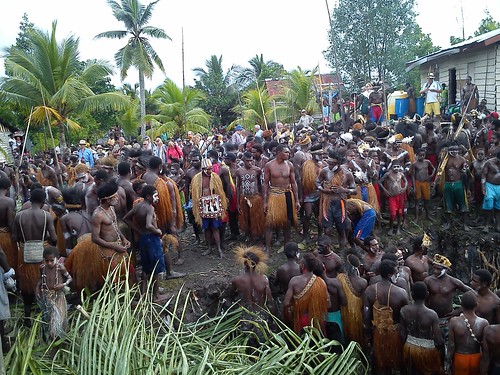 Villagers prepare to 'unveil' another new dugout canoe.
Villagers prepare to 'unveil' another new dugout canoe.
It’s hard to estimate how many people participated in the chanting and dancing. But it must have been between two hundred and three hundred at least. We were told that three villages combined their efforts to perform this ceremony. All the villagers not involved in the ceremony were watching from various vantage points. All the passengers had been very impressed by the amazing experience and the expedition crew who, of course, are widely travelled agreed that they had never seen such a spectacle.
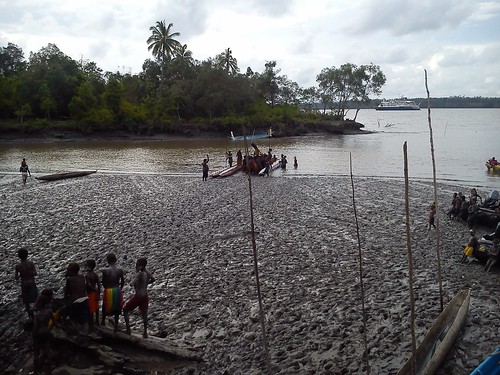 The last of the new dugout canoes is lowered into the water. In the foreground, the muddy 'beach', in the background 'Caledonian Sky' awaits our return.
The last of the new dugout canoes is lowered into the water. In the foreground, the muddy 'beach', in the background 'Caledonian Sky' awaits our return.
We slowly moved away from the landing area and proceeded along the boardwalk through the village. The houses were wooden and built on wooden piles. Most roofs were corrugated iron but a few used thatch. At one point, we passed a pushcart carried on two bicycle wheels, brightly painted and marked ‘BAKSO’: this was the mobile shop. Periodically, we passed a modern addition – solar-powered street lamps. We crossed a muddy creek with a wide variety of outboard- or inboard-powered craft. There were lots of villagers about, curious about their strange-looking visitors but not unfriendly. Children, in particular, were intrigued but readily responded to a wave or a kind word and, from time to time, I found myself with a small band of followers.
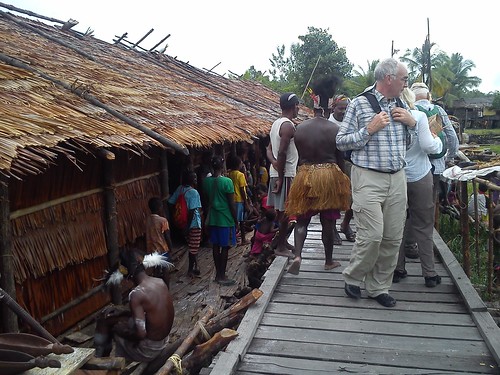 The area is famous for woodcarvings in a 'primitive style' which some villagers displayed for sale. We were told that the 'Long House' on the left was a dormitory for unmarried young men.
The area is famous for woodcarvings in a 'primitive style' which some villagers displayed for sale. We were told that the 'Long House' on the left was a dormitory for unmarried young men.
There were not just local people moving in both directions on foot along the boardwalk. Some used bicycles but there were also what looked like mopeds but were actually powered from a rechargeable battery and thus very quiet, except that, as their wheels passed over the individual slats forming the surface of the boardwalk, they produced a distinctive ‘clack-clack-clack’sound.
Continuing our walk, we passed the local power station. A dull roar from one or more diesel alternators came from inside one of a group of wooden buildings. A number of oil drums were stored on a wooden platform outside. Another part of the storage platform had a number of large distribution transformers, ready for installation.
We came to a large, wooden private house on wooden piles painted rather oddly in purple and pale blue. What caught my eye were two ‘ham’ amateur radio station signs marked ‘STASIUM RADIO AMATIR’ and the ‘call signs –‘YD9SWQ’ and ‘YD9STG’. Of course, there were quite substantial antenna installations in the garden.
After we passed an Indonesan Christian church built of wood and crossed another muddy creek, we traversed a short rural area before the buildings started again. I imagined we were now in Agats, but I couldn’t find confirmation of this, except that the boardwalk changed to an all-concrete construction supported on round columns. The actual walking surface was formed from concrete ‘paving slabs’ where the electric mopeds now produced a sort of ‘tung-click-tung-click’ as each slab rocked slightly.
On our right, the cathedral church (‘KATEDRAL’) was a striking modern design in the form of an inverted ‘V’. The broad boardwalk platform in front of the cathedral was wooden-slatted. Part of the area was marked out in white forming a series of small ‘parking bays’ for the electric mopeds. On the opposite side of the main boardwalk, there was a carved Calvary, illuminated by a single pendant electric light.
 The Cathedral Church.
The Cathedral Church.
We were invited to look around the Museum of Local Art. This was a large, airy building but rather gloomy. Although there were large windows at high level, it was starting to get dusk and there were very few electric lights in use. However, there was a wide range of carvings in the local 'primitive style' on display.
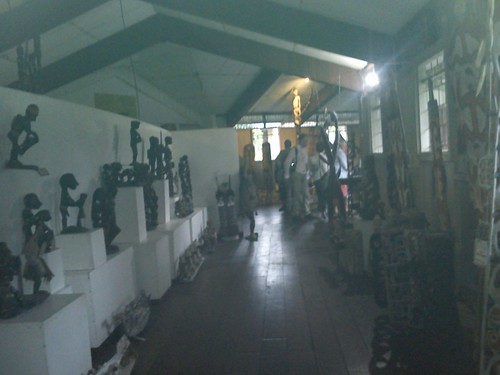 The Museum of Local Art.
The Museum of Local Art.
The Bank building on our left was distinguished by a series of flagpoles with brightly-coloured advertising flags on either side of the access boardwalk. After passing over another muddy creek with a variety of beached boats, I noticed that the shop on our right extended back some distance and seemed to be carrying very comprehensive stocks.
The next group of buildings on our right formed Agats Hospital. The Blood Transfusion Unit was particularly smart, wooden with a corrugated iron roof, pale green window frames and varnished wooden wallo cladding. There was even at least partial air conditioning. A young man approached me and, in excellent English, told me I should speak to the Doctors and find out more, pointing to a group of three people sitting under a verandah. I did so. All three were Doctors at the Emergency Unit which I was told had six beds. The main hospital adjacent had about 20 beds.
 A view of part of Agats Hospital.
A view of part of Agats Hospital.
At a crossroads in the boardwalk, there was a large piece of 'public art'. From each of the four corners of the crossroads, a curved pillar rose, joining the other pillars to form a series of arches, topped with a statue.
We passed a large, low building I took for a school because of the flagpole and the large wooden platform in front which looked like a ‘playground’. Another commercial building on our right was ‘AGATS STUDIO FOTO’ offering a Fuji film Digital Imaging Service. The large AN-NUR Mosque we passed was painted in traditional pale green and white.
We were then in what was certainly ‘Downtown Agats’ – shops on both sides of the boardwalk selling a bewildering array of goods. We saw one young man who’d presumably caught the ugly-looking catfish he was carrying. It was about three feet long and he was happy to pose for photographs. One café had a barbeque outside being prepared for action, fired with coconut shells.
 'Downtown Agats'.
'Downtown Agats'.
Now almost dark, we arrived at the shore. There was a substantial high-level concrete jetty to accommodate the larger ferries which serve Agats but there was also a low-level jetty for local boats where we joined our ‘Zodiacs’ for the journey back to our ship. The jetty area was crowded with local people, many of whom had come to see the foreigners and it was quite a jolly send-off.
 Queuing for 'Zodiacs' on the local jetty, watched by a crowd of locals on the high-level jetty.
Queuing for 'Zodiacs' on the local jetty, watched by a crowd of locals on the high-level jetty.
A most memorable experience. Next time, I’ll describe our Zodiac cruise the following morning to study the Mangrove Ecosystem around Syuru. You can find all the posts on this trip here.
My pictures
Syuru.
[Minor revisions, pictures and links to pictures added 23-Feb-2015]
 Naturalist and Zodiac Driver Simon Cook in charge of the Nature Cruise. The hydraulic crane at the stern of 'Caledonian Sky' is used to 'launch' and retrieve the Zodiacs.
Naturalist and Zodiac Driver Simon Cook in charge of the Nature Cruise. The hydraulic crane at the stern of 'Caledonian Sky' is used to 'launch' and retrieve the Zodiacs.
 The world beneath the surface (1).
The world beneath the surface (1).

 The world beneath the surface (3).
The world beneath the surface (3).
 A warning sign near the sea cucumber 'farm'.
A warning sign near the sea cucumber 'farm'.
 Surrounded by islands.
Surrounded by islands.
 Returning to 'Caledonian Skey' for lunch. There's insufficient room in the 'cradles' at the stern to stow all the Zodiacs so a second hydraulic crane on the starboard side, just astern of the egg-shaped white 'Radome' is used to stow the other Zodiacs on the 'roof'.
Returning to 'Caledonian Skey' for lunch. There's insufficient room in the 'cradles' at the stern to stow all the Zodiacs so a second hydraulic crane on the starboard side, just astern of the egg-shaped white 'Radome' is used to stow the other Zodiacs on the 'roof'.
 Lunch in the 'Lido' restaurant.
Lunch in the 'Lido' restaurant.
 Approaching Pulau Boo in a 'Zodiac'
Approaching Pulau Boo in a 'Zodiac'
 The beach at Pulau Boo with 'Caledonian Sky' in the background.
The beach at Pulau Boo with 'Caledonian Sky' in the background.
 A larger piece of 'brown' coral, surrounded by coral fragments.
A larger piece of 'brown' coral, surrounded by coral fragments.







































